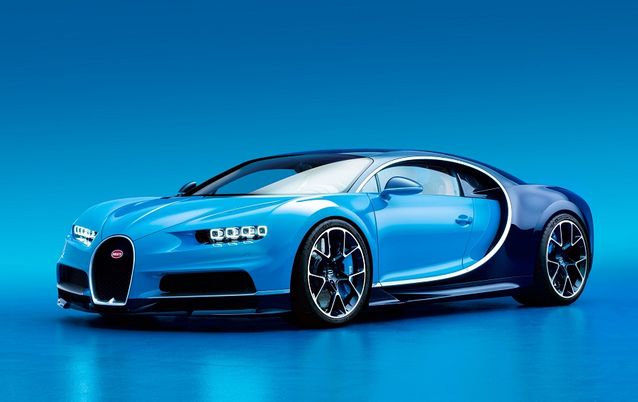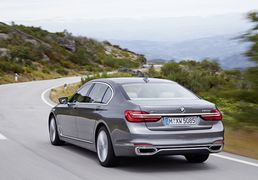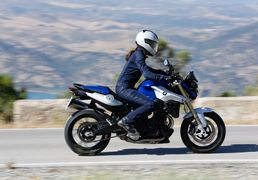GENEVA MOTOR SHOW: Power, more power — and then some
by Michael Taylor,
2016-03-03 06:27:35.0
THERE’s only one way to top the animal that rewrote the rule book for hypercars. Bugatti had to rewrite them again.
Enter the stupendous Bugatti Chiron, boasting 1,103kW of power, an astonishing 1,600Nm of torque, a 420km/h top speed and all of it backed by a Volkswagen Group warranty. And, for the insanely brave, it even has a drift mode.
If you can mount an argument that the Bugatti Veyron marked a flag-on-Everest moment for the supercar industry, it’s hard to know where to take the debate for the Chiron, which will begin production in October.
To put its numbers into perspective, the Chiron has about 372kW more than the Veyron did at its launch in 2005. The Veyron already approached the longitudinal limits of its tortured, mega-expensive tyres, but Bugatti claims the Chiron will hit 100km/h in less than 2.5 seconds, will streak beyond 200km/h in less than 6.5 seconds and will hammer beyond 300km/h in 13.5 seconds.
And the Chiron does all this with a sterling silver and enamel Bugatti badge atop the traditionally shaped horseshoe grille.
It still uses the aerodynamic tricks of having separate top-speed and handling modes, reaching out to 420km/h at the peak of its powers and 380km/h with the hydraulically raised rear wing set for maximum driving security.
Five preset modes include Lift (for keeping the nose out of trouble over gutters and speed bumps), Auto, Autobahn, Handling and Top Speed. While Lift is a low-speed solution, the next three modes are limited to just a paltry 380km/h, while you will still need to stop the car then insert and twist a Speed Key to engage the Top Speed mode for the full time-warp experience.
The dramatic styling was lead by design boss Achim Anscheidt. While attention to detail is easy to come by when you’re asked to design an all-new car once a decade, the Chiron has its own issues, most notably the torture of air across the surfaces. Anscheidt insisted the design team worked unusually closely with the engineering and aerodynamics teams to retain the visual punch without losing any aero efficiency.
Besides the horseshoe grille, there’s a front splitter strong enough to go racing with, while the thin LED lights also cunningly redirect air to cool the front brakes. There’s a semicircular set of front wings and a large central fin, which runs from the bonnet into the roof and onto the tail, to provide lateral stability at high speed, much like on modern LMP1 racers.
You could be forgiven for thinking the Chiron is a rebodied development of the mid-engined Veyron, but you’d be wrong. It’s an all-new carbon-fibre chassis, this time with a honeycomb sandwich floor and it has discarded the alloy engine cradle and now a stiffer, lighter carbon-fibre one hosts the 8l, quad-turbo W16 powerhouse.
Previewed by Bugatti boss Wolfgang Durheimer at a private Volkswagen Group event in Geneva, it’s a visual development of the Vision Gran Turismo concept car shown at the Frankfurt motor show in September.
Like the Veyron, the Chiron won’t stay as one stock model for long, with Bugatti planning a successor for each of the Veyron’s main variants, including the Grand Sport, SuperSport and Grand Vitesse.
Not for the Chiron the modern niceties of electric turbochargers or hybridised powertrains, like the McLaren P1 or the LaFerrari or the Porsche 918. Instead, the French-built hypercar will rely on using 32 individual direct-fuel injection nozzles to help drain the 100l petrol tank as fast as mechanically, hydraulically and chemically possible.
The new monocoque, constructed by CarboTech in Austria, delivers 50,000Nm/degree of torsional rigidity, which is up there with the Porsche and Audi LMP1 Le Mans racers. It’s a lot heavier, though. A lot.
The Chiron has added 155kg over the original versions of the Veyron, and it sits at 1,995kg, which can lead you to develop some frightening numbers about what a crash might look like at max speed.
It is named after Bugatti’s most famous racing driver, Louis Chiron, who raced for the marque in the 1920s and 1930s and was the official starter of the Monaco Grand Prix into the late 1970s. Chiron won the French Grand Prix in a Bugatti Type 51 and even though he also raced for Alfa Romeo, Mercedes-Benz and Maserati, he was always closely linked to Bugatti.
The Chiron is the most powerful car that’s ever been street legal and Bugatti has once again limited it to just 500 cars — and, before you ask, it’ll take €2.4m (R42m) in spare change to secure one. And it says it already has an order bank of 150 cars.
-

The frontal design of the Chiron has evolved from the Veyron. Picture: NEWSPRESS USA
-

The interior is handcrafted luxury. Picture: NEWSPRESS USA
-

The rear is sharper than that of the Veyron. Picture: NEWSPRESS USA
THERE’s only one way to top the animal that rewrote the rule book for hypercars. Bugatti had to rewrite them again.
Enter the stupendous Bugatti Chiron, boasting 1,103kW of power, an astonishing 1,600Nm of torque, a 420km/h top speed and all of it backed by a Volkswagen Group warranty. And, for the insanely brave, it even has a drift mode.
If you can mount an argument that the Bugatti Veyron marked a flag-on-Everest moment for the supercar industry, it’s hard to know where to take the debate for the Chiron, which will begin production in October.
To put its numbers into perspective, the Chiron has about 372kW more than the Veyron did at its launch in 2005. The Veyron already approached the longitudinal limits of its tortured, mega-expensive tyres, but Bugatti claims the Chiron will hit 100km/h in less than 2.5 seconds, will streak beyond 200km/h in less than 6.5 seconds and will hammer beyond 300km/h in 13.5 seconds.
And the Chiron does all this with a sterling silver and enamel Bugatti badge atop the traditionally shaped horseshoe grille.
It still uses the aerodynamic tricks of having separate top-speed and handling modes, reaching out to 420km/h at the peak of its powers and 380km/h with the hydraulically raised rear wing set for maximum driving security.
Five preset modes include Lift (for keeping the nose out of trouble over gutters and speed bumps), Auto, Autobahn, Handling and Top Speed. While Lift is a low-speed solution, the next three modes are limited to just a paltry 380km/h, while you will still need to stop the car then insert and twist a Speed Key to engage the Top Speed mode for the full time-warp experience.
The dramatic styling was lead by design boss Achim Anscheidt. While attention to detail is easy to come by when you’re asked to design an all-new car once a decade, the Chiron has its own issues, most notably the torture of air across the surfaces. Anscheidt insisted the design team worked unusually closely with the engineering and aerodynamics teams to retain the visual punch without losing any aero efficiency.
Besides the horseshoe grille, there’s a front splitter strong enough to go racing with, while the thin LED lights also cunningly redirect air to cool the front brakes. There’s a semicircular set of front wings and a large central fin, which runs from the bonnet into the roof and onto the tail, to provide lateral stability at high speed, much like on modern LMP1 racers.
You could be forgiven for thinking the Chiron is a rebodied development of the mid-engined Veyron, but you’d be wrong. It’s an all-new carbon-fibre chassis, this time with a honeycomb sandwich floor and it has discarded the alloy engine cradle and now a stiffer, lighter carbon-fibre one hosts the 8l, quad-turbo W16 powerhouse.
Previewed by Bugatti boss Wolfgang Durheimer at a private Volkswagen Group event in Geneva, it’s a visual development of the Vision Gran Turismo concept car shown at the Frankfurt motor show in September.
Like the Veyron, the Chiron won’t stay as one stock model for long, with Bugatti planning a successor for each of the Veyron’s main variants, including the Grand Sport, SuperSport and Grand Vitesse.
Not for the Chiron the modern niceties of electric turbochargers or hybridised powertrains, like the McLaren P1 or the LaFerrari or the Porsche 918. Instead, the French-built hypercar will rely on using 32 individual direct-fuel injection nozzles to help drain the 100l petrol tank as fast as mechanically, hydraulically and chemically possible.
The new monocoque, constructed by CarboTech in Austria, delivers 50,000Nm/degree of torsional rigidity, which is up there with the Porsche and Audi LMP1 Le Mans racers. It’s a lot heavier, though. A lot.
The Chiron has added 155kg over the original versions of the Veyron, and it sits at 1,995kg, which can lead you to develop some frightening numbers about what a crash might look like at max speed.
It is named after Bugatti’s most famous racing driver, Louis Chiron, who raced for the marque in the 1920s and 1930s and was the official starter of the Monaco Grand Prix into the late 1970s. Chiron won the French Grand Prix in a Bugatti Type 51 and even though he also raced for Alfa Romeo, Mercedes-Benz and Maserati, he was always closely linked to Bugatti.
The Chiron is the most powerful car that’s ever been street legal and Bugatti has once again limited it to just 500 cars — and, before you ask, it’ll take €2.4m (R42m) in spare change to secure one. And it says it already has an order bank of 150 cars.





























Change: 1.41%
Change: 1.74%
Change: 1.55%
Change: 1.65%
Change: 1.42%
Data supplied by Profile Data
Change: 0.54%
Change: -0.01%
Change: 1.41%
Change: 0.00%
Change: -0.24%
Data supplied by Profile Data
Change: 2.28%
Change: 1.80%
Change: 1.84%
Change: 2.33%
Change: 1.64%
Data supplied by Profile Data
Change: -0.50%
Change: -0.42%
Change: -0.26%
Change: -0.70%
Change: -2.53%
Data supplied by Profile Data